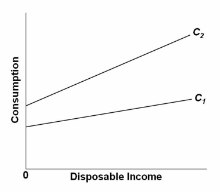Refer to the given diagram. Suppose an economy's consumption schedule shifts from C 1 to C 2 as shown in the diagram. We can say that its:

A. MPC has increased, but its APC at each income level is unchanged.
B. APC at each income level is increased, but its MPC is unchanged.
C. MPC and APC at each income level have both increased.
D. MPC and APC at each income level have both decreased.
C. MPC and APC at each income level have both increased.
You might also like to view...
When the natural unemployment rate increases,
A) both the long-run Phillips curve and the short-run Phillips curve shift leftward. B) there are no shifts of either the long-run Phillips curve or the short-run Phillips curve. C) both the long-run Phillips curve and the short-run Phillips curve shift rightward. D) the long-run Phillips curve shifts leftward, and the short-run Phillips curve shifts rightward. E) the long-run Phillips curve shifts rightward, and the short-run Phillips curve shifts leftward.
If a 20 percent increase in the price of a good does not change the quantity supplied, the
A) supply is perfectly inelastic. B) supply is unit elastic. C) supply is perfectly elastic. D) supply is elastic. E) None of the above answers is correct.
If the economy is falling below potential real GDP, which of the following would be an appropriate fiscal policy to bring the economy back to long-run aggregate supply? An increase in
A) government purchases. B) the money supply and a decrease in interest rates. C) taxes. D) oil prices.
Which of the following statements about markets and industries is TRUE?
A.A market includes buyers but not sellers. B. An industry includes buyers but not sellers. C.A market includes sellers but not buyers. D. An industry includes sellers but not buyers.